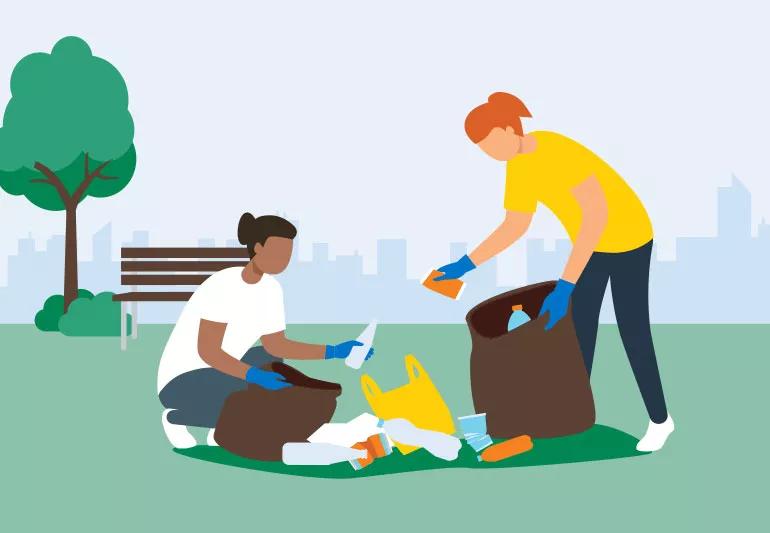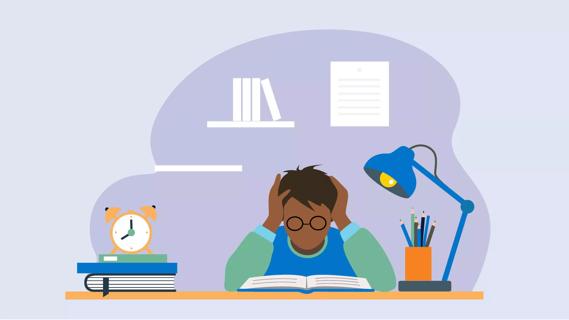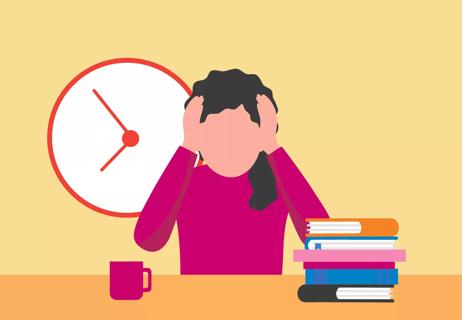Balance is key in coping with this real-world concern

Earthquakes, tsunamis, tornadoes and wildfires — there’s no shortage of natural disasters these days. As the world continues to heat up, leaders worldwide are working to find long-lasting solutions for climate change. But most days, it seems we’re getting no closer to solving the global crisis.
Cleveland Clinic is a non-profit academic medical center. Advertising on our site helps support our mission. We do not endorse non-Cleveland Clinic products or services. Policy
In fact, it’s becoming more and more difficult for people to navigate their fears of impending doom, all amidst increased levels of pollution.
What can you do when it seems like the whole world, literally, is falling apart around you? And how can you calm your climate anxiety?
Registered psychotherapist Natacha Duke, MA, RP, explains how climate change impacts your mental health, and offers coping strategies for when climate anxiety hits you hard.
Climate anxiety isn’t a medical diagnosis. But it is a fast-growing popular term used to describe a collection of symptoms triggered by long-term shifts in temperature and weather patterns. Also known as “eco-anxiety,” “eco-guilt” and “eco-grief,” climate anxiety is characterized by a chronic fear of environmental doom that’s often paralyzing and debilitating, and it can sometimes be exacerbated by existing anxiety disorders.
“Because of the COVID-19 pandemic and witnessing that crisis on a very large scale, we’ve all seen how a crisis can unfold, how quickly it happens, how it can feel and how it can really change the course of our everyday lives,” says Duke. “Because of this, climate anxiety is becoming more of an issue, especially among people who are 16 to 34.”
In a 2021 survey of 10,000 people (age 16 to 25) from 10 different countries, 84% of respondents were moderately worried about climate change. In that same study, more than 50% reported having feelings of sadness, anxiety, anger, powerlessness, helplessness and guilt. More than 45% of respondents reported that their feelings about climate change had a negative impact on their daily life and functioning. And 75% said they were frightened for the future.
“It’s one thing to think about these things abstractly, but it’s a completely different level to experience it firsthand,” notes Duke.
Living through a natural disaster brings about its own set of physical, mental and emotional challenges, including increased risk for developing post-traumatic stress disorder (PTSD).
“Climate anxiety and PTSD can be related, but they can also be very different,” she says. “If you’re reliving your experience through flashbacks and nightmares, you might be experiencing symptoms of PTSD.”
And in particular, Indigenous people are some of the most vulnerable populations to experience negative impacts as a result of ongoing direct exposure to climate change. Coupled with increased rates of food insecurity, housing shortages, lack of access to healthcare, a disruption to culture and existing socio-economic disadvantages, Indigenous people are faced with an ever-growing set of challenges that further reinforce climate anxiety.
“When we experience a natural disaster, such as an earthquake, tornado or wildfire, it’s quite common to experience psychological effects. These often include shock, increased anxiety — and depending on the level of exposure — PTSD,” states Duke. “Climate anxiety and natural disasters shake our sense of security and safety. Things we take for granted are threatened, which can create a sense of insecurity, anxiety and fear.”
No matter what triggers it, anxiety can manifest itself in different ways. You can experience a number of emotional and mental symptoms, like anger, a sense of being overwhelmed, and worry and rumination about the future. Similar to other types of anxiety, climate anxiety may also cause physical symptoms like palpitations, shortness of breath, panic, muscle tension and insomnia.
With climate anxiety specifically, there are a number of signs, symptoms and behaviors you might exhibit in response to certain triggers. Duke breaks down some of the most common signs of climate anxiety:
Climate change is such a large-scale problem, that any lingering anxiety or fear around climate change can feel very big.
“When you untangle it and look at it on a more manageable, microscopic level, it can feel more manageable,” notes Duke. “But because climate change is an issue that affects everyone, it can feel overwhelming, and helplessness can settle in.”
Anxiety is future-based, meaning you might feel a sense of some impending doom long before it happens (and even without having any evidence that it’ll actually happen at all). For some, anxiety might manifest as a constant, low-boiling worry about the environment, while others might experience a free-floating anxiety that something (anything) bad can happen at any point.
“These anxieties around climate change can be triggered by hearing about a natural disaster or reading about climate change news,” says Duke. “A worrisome, alarming headline can be triggering and cause physical manifestations, like muscle tension or shortness of breath, as well.”
According to a 2022 survey from the American Academy of Sleep Medicine, 69% of respondents reported often losing sleep over their worries about the environment.
“Sleep is often a good barometer of how stressed or anxious you’re feeling,” says Duke. “If anxiety is creeping up, you might toss and turn over your thoughts or a sense of uncertainty might keep you up.”
A loss of sleep can also have long-term impact on your mental and physical health. So, if you’re losing sleep because of anxiety or anxious thoughts, it might be adding more fuel to the fire than you initially think.
Not to be confused with doomscrolling, maladaptive scrolling is a behavior in which you seek out headlines, articles, photos and more that trigger your fears or anxieties. But why would you ever seek out the very thing you’re afraid of? Well, anxiety can sometimes cause us to look for evidence or proof of our fears to avoid a feeling of uncertainty.
“Maladaptive scrolling can lead us to look for bad news to justify how we’re feeling,” explains Duke. “Looking for evidence is a grounding technique that can be resourceful when you’re feeling anxious, but you want to ensure you’re having balanced thinking about the subjects that trigger your anxiety.”
For example, if you’re going to hunt for clues of impending doom, you should also look up some positive stories about the environment and global solutions that are being worked on and researched right now.
And as with anything, boundaries and limits on what you’re searching for and how long you spend searching is always a good practice.
When confronted with a big, seemingly insurmountable problem, it’s easy to project blame either on yourself or others who you deem responsible. The more this anger builds up, the more you increase your risk for further anxiety.
“With environmental anxieties, there’s often a lot of blame toward ourselves for not doing enough in the past or toward politicians, government entities and others for not doing more,” Duke says.
“This is our world, this is our environment, and some of us might feel that we should have done better to take care of it,” states Duke. “If we’re feeling guilt or shame around an issue, even if it’s something small, it can really be immobilizing for some of us.”
You might avoid conversations about the environment and climate change as a whole, or you might avoid activities, places and things related to the world around you as a way of avoiding environmental triggers.
A 2022 survey revealed that 45% of Americans are very or somewhat worried about having children in a world where climate change continues to be a problem. For some, making such big life decisions in response to their anxieties and fears is OK if it continues to align with their values. But if you wanted to have children and you’re in conflict with where the world is headed, you might experience some cognitive dissonance.
“If it’s causing you other mental health issues or symptoms, I think it’s worth asking yourself if you’re making these choices out of fear or if it’s aligned with your values,” advises Duke. “If fear is playing a role, I would suggest seeking the support of a mental health professional so that you can sort through your thoughts and feelings.”
So, what can you do when you’ve got climate anxiety? Well, for starters, it helps to find ways to stay informed without bulldozing your own boundaries and find ways you can get involved in a safe and productive manner.
“We don’t want to take in so much news and so much research that we feel paralyzed, overwhelmed or counterproductive,” cautions Duke. “You want to set boundaries that work for you around how much you can handle and how much you’re going to absorb.”
“If it’s important to you, you have to look at where you are right now,” advises Duke. “When you feel lost, it can help to identify your particular strengths and what you can lend to the situation.”
That means if you’ve never gotten involved in the climate crisis, maybe you should start small and focus solely on the things you can do each day to reduce your carbon footprint and your impact on the world around you. And if you’re the kind of person who does 10 things throughout the week to fight climate change, maybe you can look into researching one specific environmental cause you can dive into a little more deeply.
“Connecting with others who share the same values can help you feel like you’re making a bigger impact than what you might feel doing on your own,” Duke says. “Any kind of support group or group therapy is designed to normalize your experience and provide you with a community that lifts you up.”
But be careful: If you’re already feeling overwhelmed about the immensity of climate change and its negative impacts, getting too involved might feel like you’re getting in over your head. Check in with yourself about what you can and can’t handle (remember those self-imposed boundaries!) and be patient and kind to yourself as you navigate a path forward.
“We want to always balance things out so that we don’t become overly absorbed in our anxiety,” encourages Duke. “We want to ensure we’re taking time for other aspects of our lives and other hobbies to balance out how we’re feeling.”
That means that it’s OK to avoid headlines sometimes when you’re not feeling it, and take a walk outside instead. Self-care is sometimes a great mediator when other problems surface.
As anxiety is future-focused, you want to combat it by staying in the present. That means you might want to try grounding techniques, meditation, yoga or some other activity that calms your fears, allows you to take a deep breath and relax when things get too heated.
“It’s a dance between being concerned about the future and being able to be grounded in the here and now and come back to the present moment,” states Duke.
Building emotional resilience is the core goal of most therapies, especially cognitive behavioral therapy.
“When it comes to anxiety, learning to recognize your symptoms of anxiety, identifying when they’re becoming unmanageable and utilizing positive coping strategies will build your resilience over time,” reassures Duke. “Acknowledging your feelings and finding positive ways to self-soothe is key.”
A therapist can help guide you to finding helpful solutions that work for you in every instance. Having a toolkit at your disposal and knowing how to respond to your own anxiety can help you find ways to manage it better over time whenever it’s triggered.
“You want to keep coming back to the present moment and keep making space for change whenever possible,” Duke says.
A long walk in the woods or around the block, a beach-side stroll, a moment of peace on your back porch or feeling the grass beneath your bare feet can provide some much-needed in-the-moment relief when things feel really tough. And being in a space you want to protect and keep safe can also help you feeling better about the future.
“If you’re having difficulty concentrating, performing or you’re having some negative physical symptoms and feel like it’s getting unmanageable with the tools you usually use, a therapist can help with finding more helpful coping strategies,” reinforces Duke. “And if you’re wondering if you should talk to a therapist, that’s a sign you probably should.”
The world might not get better on its own, but by taking care of your physical, mental and emotional health, you can armor yourself with the tools needed to pave the way toward a better, brighter future for you and everyone else.
Learn more about our editorial process.

Identify your triggers, set ground rules for your break and start practicing mindfulness

Too much screen time and unrealistic expectations and perceptions and can lead to an increased risk of anxiety and depression

Although different conditons, they can occur together or cause one another

If the thought of the gym sends you spiraling, do some prep work beforehand and bring a friend along for support

Stay merry and bright by knowing your triggers and journaling throughout your visit

Being the center of attention doesn’t mean you have to exile your guest stars

Focus on a positive mindset, strong study habits and healthy living

Breathwork, sleep meditation and avoiding screens can help fight back morning anxiety

Your metabolism may torch 1,300 to 2,000 calories daily with no activity

A gentle touch in all the right places may help drain your sinuses